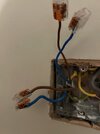Hi All,
I've got a confusing problem which has been testing me for most of the day and I'm now ready to admit defeat and ask for help!
This switch in my porch controls 2 sets of lights and I assume there are some junction boxes hidden in the ceiling or in the wall somewhere but this is a new house for us and I didn't put them in, so have failed to find them.
1. An outside wall lantern (the thin blue/brown pair)
2. Some outside low level lights on the driveway (thick blue/brown pair)
When I test across the thin blue/brown pair I get 240v on a multimeter and if I drop these into a single gang switch with brown in common and blue in L1, I get the expected behaviour and everything is fine.
However, the thick brown and blue pair carry no voltage on testing with the multimeter.
If I bundle them all into the same switch (2 blues to L1, 2 brownto common) I get weird behaviour in that flicking the switch one way will turn on the wall lantern, flicking it the other way will turn off the wall lantern and turn on the low level lighting. They can never be on or off at the same time, one is always on.
Now on the verge of madness, any help appreciated.
I've got a confusing problem which has been testing me for most of the day and I'm now ready to admit defeat and ask for help!
This switch in my porch controls 2 sets of lights and I assume there are some junction boxes hidden in the ceiling or in the wall somewhere but this is a new house for us and I didn't put them in, so have failed to find them.
1. An outside wall lantern (the thin blue/brown pair)
2. Some outside low level lights on the driveway (thick blue/brown pair)
When I test across the thin blue/brown pair I get 240v on a multimeter and if I drop these into a single gang switch with brown in common and blue in L1, I get the expected behaviour and everything is fine.
However, the thick brown and blue pair carry no voltage on testing with the multimeter.
If I bundle them all into the same switch (2 blues to L1, 2 brownto common) I get weird behaviour in that flicking the switch one way will turn on the wall lantern, flicking it the other way will turn off the wall lantern and turn on the low level lighting. They can never be on or off at the same time, one is always on.
Now on the verge of madness, any help appreciated.



